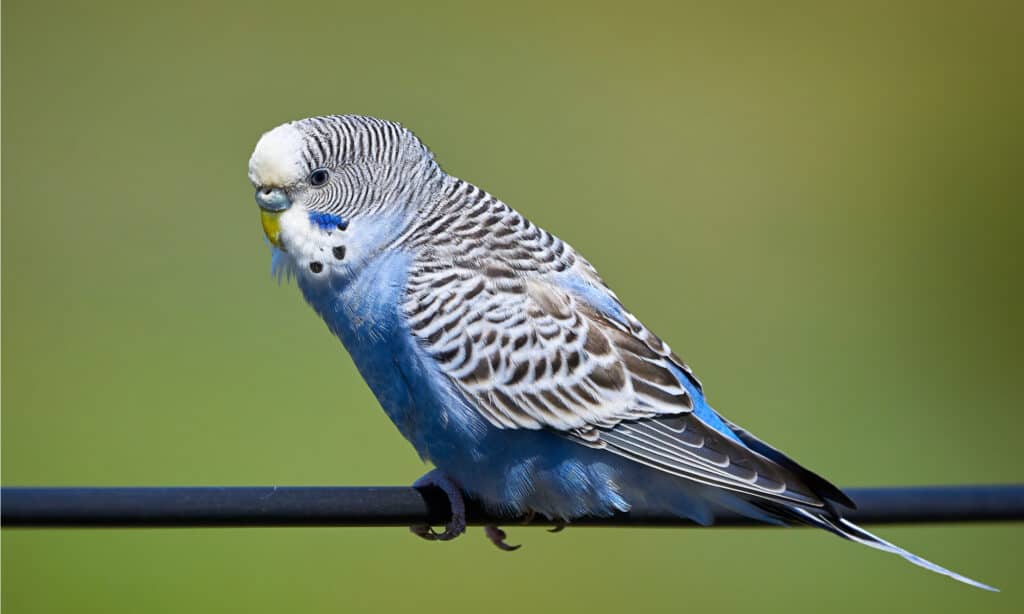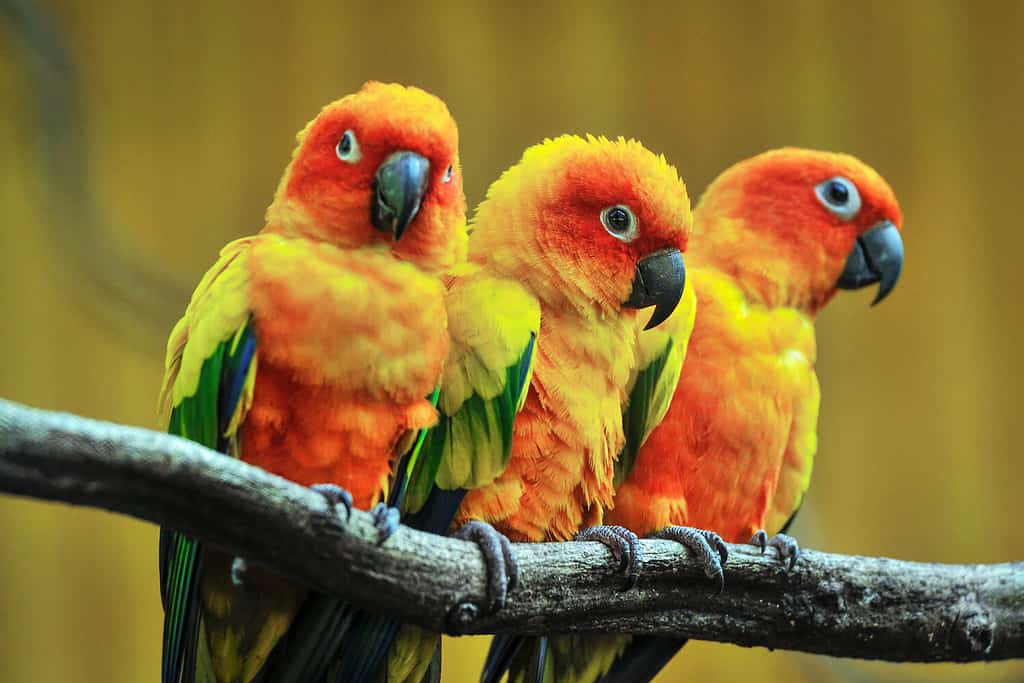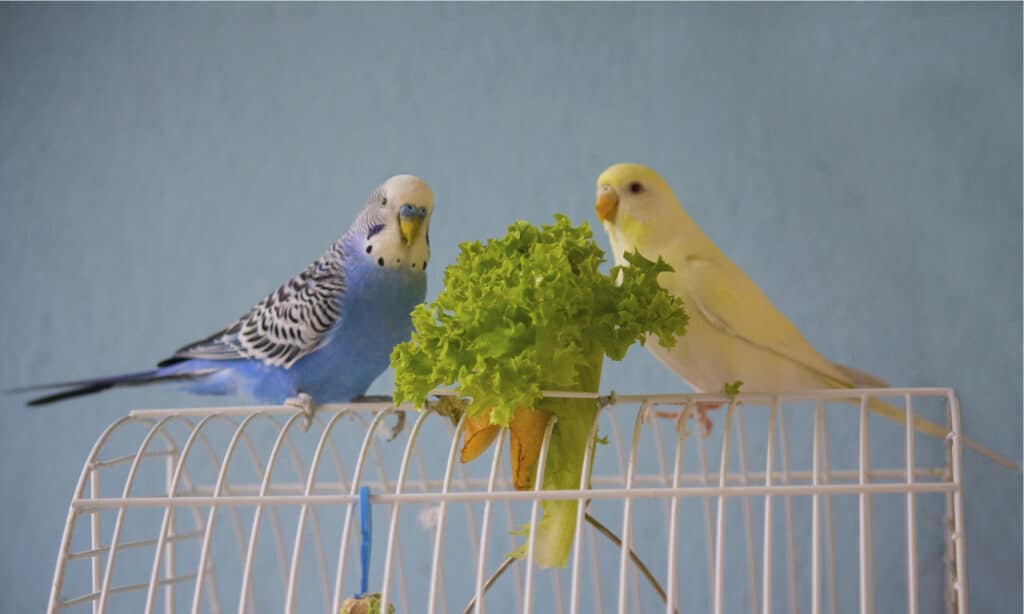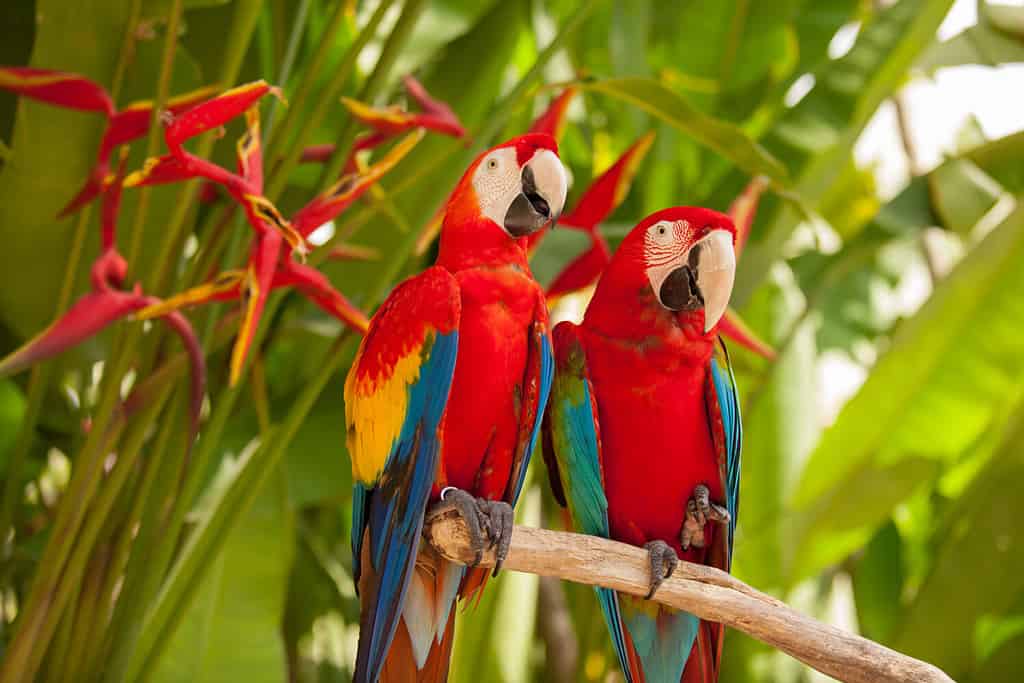If you’re seeking to adopt a parrot, or are just curious about parrots in general, it can be important and interesting to understand the differences that exist between males and females. For parrots, and most birds, distinguishing a male from a female is a more difficult task than it is for, say, a dog or a cat. This is because most parrots are not sexually dimorphic.
Sexual dimorphism refers to the existence of substantial differences between the sexes. For dogs, for example, you can see the reproductive organs on the outside of the body for each sex. Additionally, males are often larger and more muscular. In parrots, those differences don’t exist in such a clear way. They generally aren’t sexually dimorphic, meaning sex doesn’t serve as a determinant for many of their traits.
Parrots and birds also have internal reproductive organs. This means that a genital assessment cannot be done without surgery or an X-ray. This makes the task of identifying the sex of a parrot fairly difficult. One of the easiest ways to sex a parrot is by having DNA test done on the bird, which is cheap and simple, and will rear clear results.
While most parrots aren’t sexually dimorphic, some species exhibit slight differences between male and female birds. For most parrots that have sexual dimorphism, the differences are subtle. However, there are a few exceptions of parrot species that have more obvious differences between the sexes.
To understand the difference between male and female parrots, explore this list. It will also highlight the ways to determine for certain the sex of a parrot. If you’re looking to bring a parrot home, this list will be a great place to start.
| Male Parrots | Female Parrots | |
|---|---|---|
| Coloration | Brighter & deeper | Duller & browner |
| Behavior | Active | More affectionate |
| Noise level | Louder | Quieter |
| Vocabulary | Generally larger | Generally smaller |
Coloration

Parakeets
are a species of parrot that exhibit some coloration differences between sexes. The cere of male parakeets is dark blue, while female parakeets have a lighter-colored cere. The cere pictured above is very light in color, so it’s likely this budgie is a female.
©Adrian Eugen Ciobaniuc/Shutterstock.com
Some, but not all, species of parrots exhibit some coloration differences between the sexes. The most common areas to notice coloration differences are the feathers, beak, and cere (the covering at the upper beak). Generally speaking, if the species exhibits coloration differences, the male will be more colorful or have deeper coloration, while the female will have paler or browner coloration.
Cockatoos are a type of parrot that exhibit some coloration differences. Their coloration differences appear in their eyes. If the bird has a red iris, she is a female! If the bird has a brown iris, he’s a male! Cockatiels also have some coloration differences between sexes. For example, male white-faced cockatiels have white faces, while females often have grey faces.
Even in species that exhibit some coloration differences between sexes, it’s important to know that this isn’t a surefire way to determine the sex of the bird. Because parrots as a whole are not sexually dimorphic, it’s important to use either scientifically proven ways of testing sex. DNA testing is the most utilized method for parrot owners.
Behavior

Parrots are incredibly unique and intelligent birds. They have very different personalities from one another, so it’s difficult to generalize species-specific traits or differences in personality between the sexes. Some birds are affectionate, while others are shy. It’s important to get to know the bird you bring home!
©Yatra4289/Shutterstock.com
With many types of animals, there can be observed behavioral differences between males and females. In parrots, these behavioral differences are incredibly minor. Additionally, it’s important to note that personality can vary significantly from bird to bird, so while these trends may exist in some species, analyzing behavioral differences is not a good way to determine the sex of your bird.
Generally, male birds are a bit more active and social than female birds. That being said, it’s common for female birds to be more affectionate. Again, it’s vital to note that personalities of birds are unique. So you may very well adopt a female who is hyperactive and a male who is incredibly cuddly! However, in general, it’s fair to identify this trend between males and females.
Aggression in parrots is a personality trait that some birds possess, but males appear to be slightly more aggressive. Both sexes bite equally hard when provoked, however! Aggression is a characteristic that appears more so as an individual personality trait than a species trait. Take time to learn the personality of your bird to minimize aggression.
Noise Level
One minor observation between male and female parrots is their noise level. Again, this difference doesn’t exist for all birds, and individual birds vary substantially from one to another. As a trend, males are chattier than females. However, it’s very possible to bring home a loud female and a shy male. Noise level should not be used as a way of determining the sex of the bird.
Vocabulary

Parakeets are one of the smallest species of parrots. They demonstrate sexual dimorphism in their coloration, as well as in their vocabulary. However, it’s important to note that even parakeets differ substantially from one another.
©DmyTo/Shutterstock.com
Another minor trend that exists in some species of parrots is a vocabulary difference. It appears that males have a broader vocabulary of noises and words than females in some cases. Again, like many of the other traits, this depends on the individual bird. It also depends on the parrot species. Female macaws, for example, have no trouble learning and repeating a broad variety of words.
Cockatiels and parakeets tend to exhibit this vocabulary difference, though. If you’re purchasing a bird with the intent to teach them a wide variety of songs and words, a male cockatiel or parakeet may be a better choice than a female.
Other Species-Specific Differences
While most species of parrots don’t demonstrate any sort of sexual dimorphism, some species demonstrate significant sexual differences! The clearest example of sexual dimorphism in parrots is the eclectus parrots. Males are green with yellow beaks, while females are blue and red! It’s easy to determine the sex of these sorts of parrots through their coloration.
Parakeets, as discussed above, also have some substantial differences between sexes. Rose-ringed parakeets have even clearer differences. Males have a “necklace” that is red or black that circles the entirety of their necks, while female rose-ringed parakeets do not.
While some species exhibit sexual dimorphism, the best ways to determine a parrot’s gender remain DNA testing or surgical testing. The untrained eye may not be able to identify the visual differences between even sexually dimorphic parrots, so it’s best to rely on experts!
How To Tell A Parrot’s Gender

Determining the sex of a parrot is not as simple as determining the sex of many other types of pets. However, a veterinarian will be able to assist you in concluding the sex of your bird!
©Katia Titova/Shutterstock.com
As discussed above, the best way to ensure accurate sexing of your bird is by undergoing either DNA testing or surgical testing. Knowing the sex of your bird is an important element of caring for your parrot. Pregnancy and other medical differences exist between the sexes, so effective care requires sexing the parrot accurately.
Here are the two best methods for determining the sex of your bird!
DNA Testing
DNA testing is a safe and simple method of determining the sex of your bird. To DNA test a parrot, blood feathers are removed and analyzed for sexual markers. Your veternarian’s office will be able to provide this service, and it’s not very expensive! It generally costs around $20 to DNA test your parrot, and results are generally returned in under a week. DNA testing is quick, cheap, and non-invasive.
Surgical Testing
Another way to go about determining the sex of your bird is through surgical testing. This can be surgical or endoscopic, and is a much more invasive procedure for determining your parrot’s sex. However, the veterinarian performing the surgical testing can also take a look at the health of your parrot’s reproductive organs! An avian endoscopy is more expensive than DNA testing. In fact, you can expect to pay several hundred dollars for the procedure. However, you’ll have more knowledge about the health of your bird.
Conclusion
While most parrots are not sexually dimorphic, it’s still incredibly important to understand the sex of your bird. DNA testing and endoscopy are two of the most common methods for determining, with certainty, your parrot’s sex. While some species, such as parakeets, have some differences between the sexes, refer to your veterinarian for advice on your specific bird.
The photo featured at the top of this post is © iStock.com/apichon_tee
Thank you for reading! Have some feedback for us? Contact the AZ Animals editorial team.







